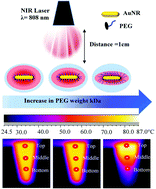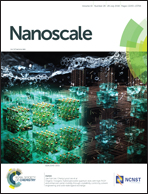The influence of polyethylene glycol passivation on the surface plasmon resonance induced photothermal properties of gold nanorods†
Abstract
Gold nanorods (AuNRs) possess unique photothermal properties due to their strong plasmonic absorption in the near-infrared region of the electromagnetic spectrum. They have been explored widely as an alternative or a complement to chemotherapy in cancer treatment. However, the use of AuNRs as an injectable medicine is greatly hindered by their stability in biological media. Therefore, studies have been focused on improving the stability of AuNRs by introducing biocompatible surface functionalizations such as polyethylene glycol (PEG) coatings. However, these coatings can affect heat conduction and alter their photothermal behavior. Herein, we studied how functionalization of AuNRs with PEG chains of different molecular weights determined the temperature distribution of suspensions under near-infrared irradiation, cell uptake in vitro, and hyperthermia-induced cytotoxicity. Thermogravimetric analysis of the PEG-conjugated AuNRs exhibited slightly different PEG mass fractions of 12.0%, 12.7%, and 18.5% for PEG chains with molecular weights of 2, 5, and 10 kDa, respectively, implying distinct structures for PEG brushes. When exposed to near-infrared radiation, we found greater temperatures and temperature gradients for longer PEG chains, while rapid aggregation was observed in unmodified (raw) AuNRs. The effect of the PEG coating on heat transport was investigated using molecular dynamics simulations, which revealed the atomic scale structure of the PEG brushes and demonstrated lower thermal conductivity for PEG-coated AuNRs than for unmodified AuNRs. We also characterized the uptake of the AuNRs into mouse melanoma cells in vitro and determined their ability to kill these cells when subjected to near-infrared radiation. For all PEG-coated AuNRs, exposure to 10 s of near-infrared radiation significantly reduced cell viability relative to unirradiated controls, with this viability further decreasing with increasing AuNR doses, indicating potential phototherapeutic effects. The 5 kDa PEG coating appeared to yield the best performance, yielding significant phototoxicity at even the lowest dose considered (0.5 μg mL−1), while also exhibiting high colloidal stability, which could help in rational design consideration of AuNRs for NIR induced photothermal therapy.

- This article is part of the themed collection: International Year of the Periodic Table: Precious metals for cancer treatment


 Please wait while we load your content...
Please wait while we load your content...